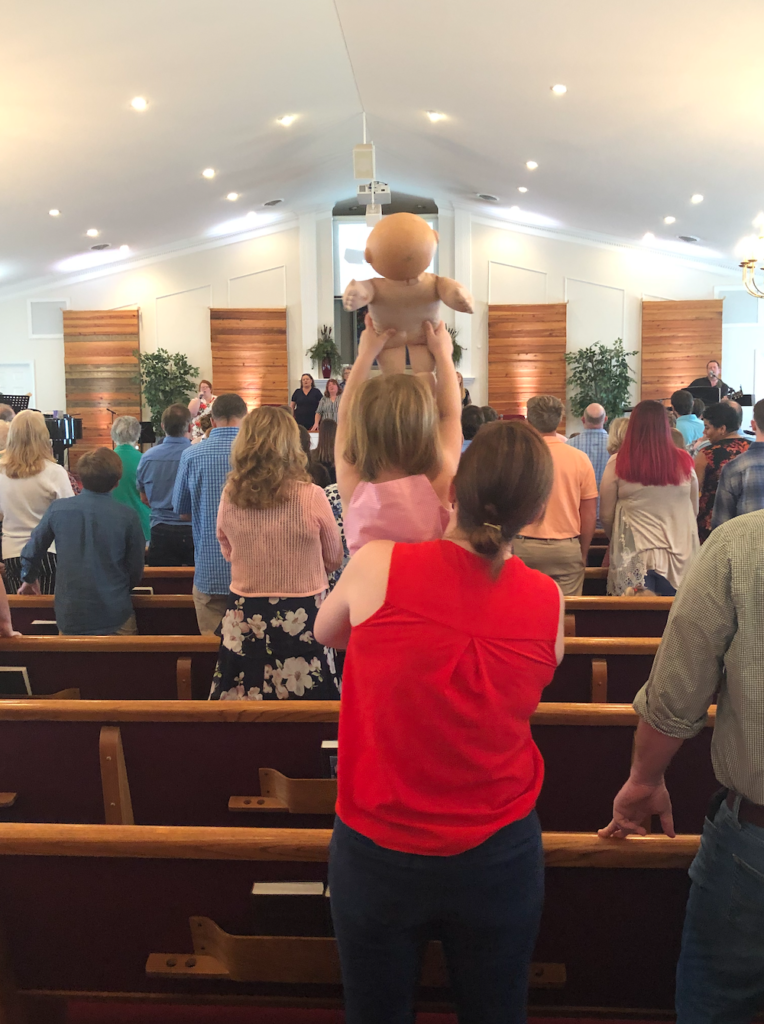“The Supreme Life”
A Sermon Series in Colossians
“The Christian’s Extension of the Gospel”
Colossians 1:24-2:5
Introduction
A pastor named Epaphras was leading a church in Colossae and there was something so troubling to him that was going on in the church that it drove him to travel to Paul in Rome (about 1,000 miles) to seek his help and to have an authoritative address (Paul as an apostle) to the issue.
In the part that we will look at today we begin to get an idea of what the problem was. The ancient society was influenced by Greek philosophy, specifically Plato. Plato believed that in the heavens there was an ideal for everything here on earth. A perfect ideal tree, and what we see here are shadows, copies, reflections of that ideal (so there is variety and differences).
So when Jesus comes along, they try to blend their worldly philosophy with Christianity. There was also the belief that anything of matter was evil. So, if Jesus was God he couldn’t be material, He had to be spiritual. According to them, Jesus was not physically here, He only appeared to be real, but was really a spirit only (in fact they believed that His feet never really touched the ground).
So in chapter 1 we see Jesus as (v. 15) “the image of the invisible God, the firstborn of all creation. 16 For by him all things were created, in heaven and on earth, visible and invisible, whether thrones or dominions or rulers or authorities—all things were created through him and for him. 17 And he is before all things, and in him all things hold together. 18 And he is the head of the body, the church. He is the beginning, the firstborn from the dead, that in everything he might be preeminent. 19 For in him all the fullness of God was pleased to dwell, 20 and through him to reconcile to himself all things, whether on earth or in heaven, making peace by the blood of his cross.”
Jesus was fully God who became fully man and made the relationship between God and man right again by his dying a cross. What is at stake is the gospel that the church had correctly received from Epaphras being corrupted by the philosophies of the world.
Prayer
The Extension of the Gospel Involves Suffering (vv. 1:24-25)
24 Now I rejoice in my sufferings for your sake, and in my flesh I am filling up what is lacking in Christ’s afflictions for the sake of his body, that is, the church, 25 of which I became a minister according to the stewardship from God that was given to me for you, to make the word of God fully known,
Paul is in prison and with a chain on his wrist he writes, “I rejoice in my sufferings,” “Now when I contemplate the lavish wealth of God’s mercy, now when I see all the glory of bearing a part in this magnificent work, my sorrow is turned into joy.”[1]
When Paul says, “filling up what is lacking in Christ’s afflictions,” he does not mean that Christ’s crucifixion and death were not enough, be has already made it plain here and in other books that Christ’s death alone is what is needed for salvation (not works, family lineage, following the law, etc.)
2 Corinthians 1:5 “For as we share abundantly in Christ’s sufferings,” but instead Paul is an extension of Christ’s ministry, and he is suffering on prison, while he writes this book. “The Church is built up by repeated acts of self-denial in successive individuals and successive generations.”[2] They continue the work that Christ began.
In the ancient world if you were the minister of a pagan religion, it was very common to have a slow revealing of secret information, and special knowledge. Once you get to a higher level, shown your loyalty or dedication, then new information would be revealed, and then the person was to keep these things secret in their closed circle. The Christian mystery is revealed to all, and the information is complete from the beginning.
Paul is a minister and he understands his job is to “make the word of God fully known.” We as believers are to follow Jesus’ and Paul’s example to make the word of God fully known, and because we live in a world hostile to the truth of the gospel it may also involve suffering.
Paul is an extension of Jesus’ ministry and he is in prison, Epaphras is an extension of Jesus’ ministry and he traveled 1000 miles for the sake the health of this church, and the church at Colossae is an extension of Jesus’ ministry – and there is a danger that the word of God may not be fully known, but instead corrupted.
The Extension of the Gospel Includes Everyone (vv. 1:26-27)
26 the mystery hidden for ages and generations but now revealed to his saints. 27 To them God chose to make known how great among the Gentiles are the riches of the glory of this mystery, which is Christ in you, the hope of glory.
“Christ in you,” – “God and his plan for salvation that had remained hidden in the past but that had now been revealed.” When the Jewish leadership of Jesus’ day should crucify him! Crucify Him! And the demons of hell rejoiced as they saw Christ on the cross, they had no idea that this was the plan the entire time for the redemption of humanity. This plan for salvation now includes not just the Jewish people, but the entire world. By faith, anyone could be “in Christ,” and as Paul says here, “Christ in you.” Because Jesus is our head, our representative, and we are his people – we have a hope of glory.
The Extension of the Gospel is Difficult Work (vv. 1:28-29)
28 Him we proclaim, warning everyone and teaching everyone with all wisdom, that we may present everyone mature in Christ. 29 For this I toil, struggling with all his energy that he powerfully works within me.
It is “Him,” Jesus we proclaim – we don’t proclaim our preferences, our agendas, our wants, our opinions – we proclaim Jesus. With that proclamation are two things 1) warnings (to stimulate repentance), and 2) teachings (to enhance faith). Warnings are what the Bible says about the sin of this world and its affects upon our lives (we warn people of the danger of sin, we don’t placate to it), and we teach what the Bible says and how our lives need to be changed and how we profit from applying to our lives, by doing what it says.
This warning and teaching has to be done “with all wisdom,” Jesus said to “speak the truth in love. (Eph. 4:15)” What you say matters, and how you say it matters as well. What you say may be true, but if you say it in an unwise manner, it will not be received.
When we use wisdom to properly warn and teach people, they then mature in their faith. Paul says that this is a toil and struggle and it takes all his energy. The proclamation of Jesus and the warning and teaching to others is hard (even for an apostle). And when Paul says, “For this I toil,” is a word picture of an athlete in his training, and then contending.
It is an exhausting work – that we all share a part. This is the wonder of the church – each using their gifts, talents, life experience, doing their part (as Paul describes a body or feet, hands, etc.) to expand the work of Christ, the gospel. But what makes it exhausting is . . .
People don’t like to be told what they are doing is wrong (unrepentant),
and they believe they know everything (unteachable).
Paul is in prison for his dealing with one heretical teaching in Ephesus (mixing the law with faith), and now he has received a pastor from Colossae with another false teaching -church work is tiring. There is an “Intellectual exclusiveness taught by the Gnosticizers”[3] Plato and Aristotle both taught a form of higher philosophy, it relates to those who have transcended the bounds of the material. The common everyday believers had faith in Christ, but there was a secret mystery of Christ that could be achieved.
The Extension of the Gospel Leads Us to Encourage Others (vv. 2:2-3)
2 For I want you to know how great a struggle I have for you and for those at Laodicea and for all who have not seen me face to face, 2 that their hearts may be encouraged, being knit together in love, to reach all the riches of full assurance of understanding and the knowledge of God’s mystery, which is Christ, 3 in whom are hidden all the treasures of wisdom and knowledge.
Paul talks about his struggle (continuing the image of an athlete in an arena) and how hard the gospel ministry is (for their church and he mentions another church in Laodicea), and for those believers he has never met and he wants, “their hearts may be encouraged,” – The word used for “encouraged in heart” or “to have hearts encouraged” is therefore a way of referring to an encouragement that touches the deepest part of our being and that affects every aspect of our persons.”[4] The word encourage means to pull someone next to you, beside you – by being next to you they are lifted up.
What should encourage us is not secrets or false promises
but that we are struggling, like Paul, for the continuance of the gospel.
He also wants his ministry to unite them, to “knit them together,” and the context that surrounds all of this is love. What unites us, and those who proclaim Jesus, is our knowledge and proper understanding of the gospel, and who Jesus is, and what He has done for humanity. We should not be knit together by anything but our love for Jesus and his crucifixion. The church is where we gather to talk about Jesus, to sing about Jesus, to study Jesus’ teachings, — we are knit together by our knowledge and love for Him.
Let me insert here the importance of church membership – when a person joins a church they are saying, “I agree with this church’s beliefs and how they are proclaiming the truth of the gospel, and what they teach about Jesus and His Word. I therefore am going to live out the Christian life in fellowship with these other believers in love.”
A church should not tolerate any teaching or beliefs within its fellowship that teach a corrupted Jesus, or twists the Bible to mean something it does not. But it is also the unity in the expression of the gospel that is a witness to the world, “The late Francis Schaeffer called the unity of the church “the final apologetic” to the watching world.”
(v. 3) “in whom are hidden all the treasures of wisdom and knowledge” – “Christ is the one in whom is to be found all that you need in order to understand spiritual reality and to lead a life pleasing to God.”[5] When you place your faith in Jesus – you get Jesus (you don’t fly, move things with your mind, or project to other places, you don’t get special powers, you don’t learn hand gestures to enter other dimensions, or secret knowledge or spells. You get Jesus in the beginning of your journey, and He is with you all the way to the end – Paul wants us to understand Jesus is enough (He is preeminent). The work of the gospel is the work.
(v. 3) In verse three we see the word apocryphal – this word was applied to esoteric writings, where sectarians claimed a secret authority and they carefully guarded their publications or secret books. Jesus is the revelation of all true wisdom and knowledge.
People want an easy access to spiritual growth.
Your Journey to Find Spiritual Truth and Fulfillment
Begins with Jesus and Ends With Jesus.
“The basic attack of all false systems throughout history has been to deny either Christ’s deity, His sufficiency to save and sanctify, or both. Any group or person doing so is guilty of teaching “doctrines of demons” (1 Tim. 4:1). As purveyors of another gospel, they are accursed (Gal. 1:8). Believers need to have a settled conviction about Christ’s deity and sufficiency to be able to withstand the onslaught of such false teaching.”[6]
The Importance of Extending the Correct Gospel (vv. 2:4-5)
4 I say this in order that no one may delude you with plausible arguments. 5 For though I am absent in body, yet I am with you in spirit, rejoicing to see your good order and the firmness of your faith in Christ.
(v. 4) “delude you with plausible arguments,” – Mankind has always asked the question, “Why am I here?” or “Where am I going?” “The word philosophy comes from two Greek words, phileo, “to love” and sophia, “wisdom.” Philosophy is a love and pursuit of wisdom. Since the ancients there have been many who seek to explain the universe.
Any time we seek to explain the universe and leave God out of it our thoughts become dark and we realize we are without hope. Romans 1:21-22 describes it this way, “For although they knew God, they did not honor him as God or give thanks to him, but they became futile in their thinking, and their foolish hearts were darkened. 22 Claiming to be wise, they became fools,”
Paul does not give us the specific danger the church at Colossae faced, but he reminds them of Christ’s role in the universe. He is calling the church to be aware, “to watch out,” to a constant awareness because danger is near. The church constantly faces the danger of false teachers. Jesus warns in Matthew 7:15, “Beware of false prophets, who come to you in sheep’s clothing but inwardly are ravenous wolves.”
These false teachers “delude” them. Is a compound word made up of “booty” – captured materials form war, and “to carry off.” It means to kidnap, or to carry off spoils of war. We must be careful not to allow ourselves to become pray of a false teacher who will carry us off as captives of war.
These false teachers carry off church members “with plausible arguments,” – the root of these words means deceit, fraud, or trick.” Whatever the false teaching was that drive this pastor to seek Paul’s help was not what it appeared to be. No matter how religious and profound it may have sounded and appeared to them, it was false and hollow.
In the following verses (that we will get to next time) Paul is going to give two specific examples of these arguments that seem plausible at the outset, but ultimately show themselves to be false and dangerous. But ultimately, we like Adam and Eve, stand at the Tree of the Knowledge of Good and Evil.
God said you can eat from any tree in the garden except this one tress, but look what happens in Genesis 3:6 “So when the woman saw that the tree was good for food, and that it was a delight to the eyes, and that the tree was to be desired to make one wise,2 she took of its fruit and ate, and she also gave some to her husband who was with her, and he ate.” Satan promised them hidden knowledge that God was keeping from them. Paul is telling us that we have the full knowledge of wisdom and understanding in Christ – God has held nothing back.
Whenever we, as human beings, take God out of the equation, when we place ourselves as god of the universe, we allow ourselves to be carried off into lies. Adam and Eve thought they knew better than God what was good for them. This is the fall of mankind. When I put myself over God’s Word, then I am doing the same thing and Adam and Eve in the garden.
It’s all about Jesus.
_________________
[1] T.K. Abbott, The International Critical Commentary, The Epistles to the Ephesians and to the Colossians (Edinburgh, Scotland; T&T Clark Publishing) 228.
[2] J. B. Lightfoot, St. Paul’s Epistles to the Colossians and to Philemon (Lynn, Massachusetts; Hendrickson Publishing, 1982) 166.
[3] Lightfoot, 170.
[4] Douglas Moo, The Letters to the Colossians and to Philemon (Grand Rapids, Michigan; William B. Eerdmans Publishing Company, 2008) 165.
[5] Moo, 169.
[6] John MacArthur, The MacArthur New Testament Commentary, Colossians and Philemon (Chicago, Illinois; Moody Publishing, 1992) 90.

 So church is starting back and for a short season we are following social distancing and staying together during the entire service. Part of the new-normal is the recognition that your children will be with you during the service, and most churches have elected to keep the children in the services. So, there you are, in the service, and your little ones are crawling under your feet, making clicking noises during the prayer time, and you are completely distracted.
So church is starting back and for a short season we are following social distancing and staying together during the entire service. Part of the new-normal is the recognition that your children will be with you during the service, and most churches have elected to keep the children in the services. So, there you are, in the service, and your little ones are crawling under your feet, making clicking noises during the prayer time, and you are completely distracted. Matthew 13:10-15
Matthew 13:10-15